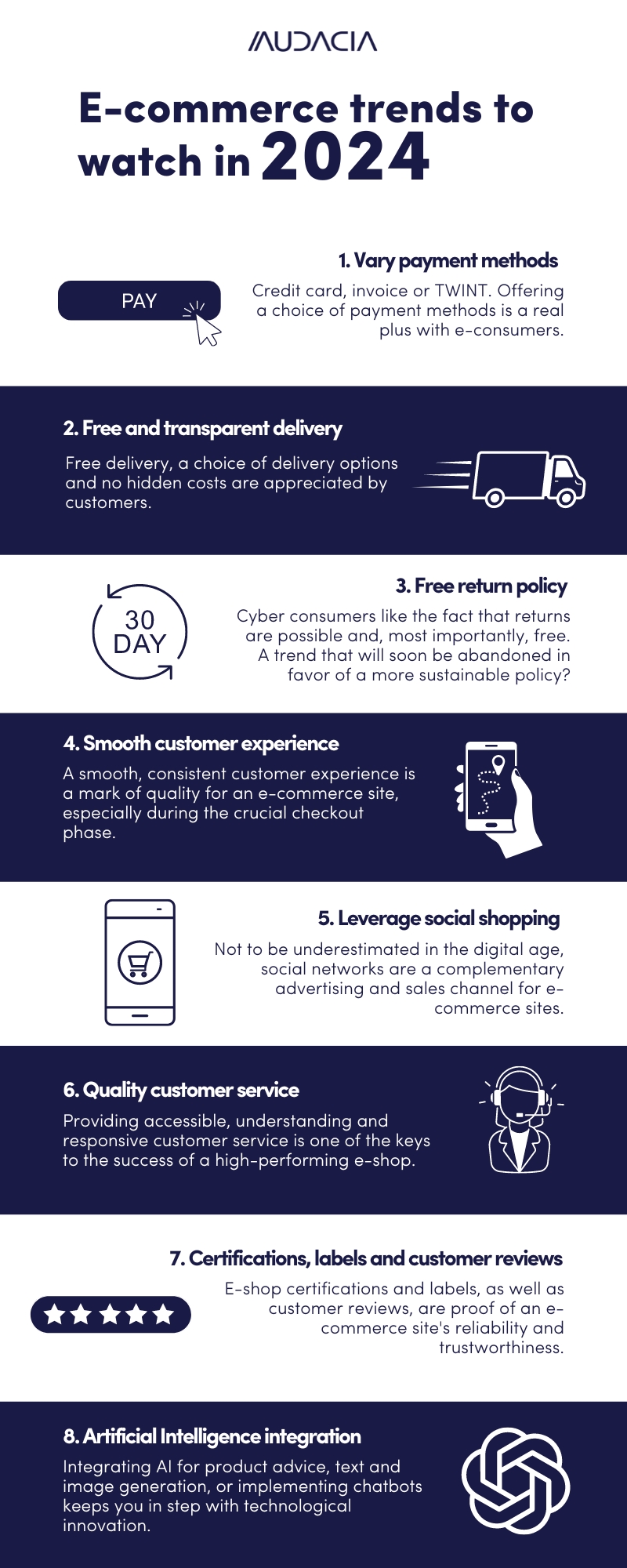According to the 2023 barometer of Swiss Post and the online commerce report by Mollie, we list for you the top e-commerce trends to follow to ensure the performance of your e-shop in 2024, both in Switzerland and abroad.
As e-commerce is a highly volatile sector, it is essential to anticipate and identify trends and innovations and adapt to them quickly to satisfy customers. This article primarily focuses on current shopping habits and expectations of e-consumers that must be considered by online commerce players.
1. A Variety of Payment Methods
The first e-commerce trend for 2024, a crucial element for an efficient online shop, is to offer users a choice of payment methods. Credit cards, invoices, or other options like TWINT for Switzerland… Customers appreciate having multiple ways to pay for their orders. Furthermore, with the impact of inflation and the decrease in purchasing power, deferred payments are a legitimate option to consider.
2. Free and Transparent Delivery Charges
Another essential element for your e-commerce site: everything related to delivery. Delivery charges often drive customers away, especially if they are hidden. The choice of delivery mode (free, express, customized) and the order tracking system are other assets for an online store. Hidden costs, additional delivery fees, and no available delivery options for a particular country are the main reasons why users cancel their online orders.
3. A Policy of Free Returns
A trend that might disappear in the near future, the return of items purchased online remains a very popular option among e-consumers. Even if the ecological and sustainable aspect is often debated, customers like being able to return one or more products for free that they ultimately do not wish to buy. It’s up to you to balance practicality and sustainability and especially to communicate the sales conditions on your site clearly.
To stay on the ecological aspect, an e-commerce site can also add value in the eyes of customers by using custom-sized parcels, recycled materials, or reusable packaging. It should also be noted that online consumers are increasingly interested in information about the origin of products.
4. A Streamlined Customer Journey
Ensuring a clear, consistent, and smooth customer journey will add great value to your e-commerce site. From consideration to loyalty through the decision to purchase, an optimally orchestrated customer journey will maximize your profitability. The checkout phase, which should include appropriate payment processes, is notably one of the key stages of the customer experience.
5. The Impact of Social Shopping
An e-merchant must not overlook social networks for managing their online store. In addition to advertising and promotional purposes, Facebook, Instagram, or TikTok also serve as additional sales platforms for products and services. Another channel to exploit to boost your sales and thus develop the visibility and activity of your e-commerce site.
6. Quality Customer Service
Whether pre or post-sale, customer service is a key department for an e-commerce brand. E-consumers will appreciate being able to easily and quickly contact you via various channels: email, contact form, and also phone. Your goal? To offer an available, responsive, and understanding service that can best resolve customer inquiries and ensure their retention. Remember that a satisfied customer is a customer who will return to you!
7. The Importance of Certifications, Labels, and Customer Reviews
The certifications and labels of e-commerce sites and the reviews left by customers are important indicators that can make a difference in the purchasing decisions of online consumers. ISO 9001/14001, B Corp, or even Trusted Shops or Swiss Online Guarantee… these labels and certifications attest to the seriousness and trustworthiness of your e-commerce, an element that can favor you over a competitor. Even more influential, the reviews left by customers (reviews) can also tip the scales and help convince consumers before purchasing a product or service.
8. Integrating AI in E-Commerce
Artificial Intelligence is on everyone’s lips, so why not take advantage of it? However, be careful to use it wisely: AI can truly serve as an interesting tool for e-merchants to generate texts, images, or even implement chatbots. For example, Jumbo and Brack.ch use artificial intelligence for product advice and Digitec Galaxus complements its search features with an interactive AI capable of handling complex requests. Artificial intelligence could well bring a breath of fresh air to e-commerce in the coming years, so why not try to exploit this tool for your online activities?

The State of the E-Commerce Market in Switzerland
According to the report by La Poste on the habits of e-consumers in 2023, over 75% of respondents make online purchases every month. More than ¾ of participants aged 34 and under primarily make their purchases online via their smartphones, while older people use computers.
Apart from the usual search engines, internet users primarily visit marketplaces such as Digitec Galaxus, Zalando, Amazon and Ricardo. However, be aware of the emergence of foreign players like Temu and Shein in the market. The most popular sectors among online consumers are travel and events, followed by books, music, and movies, clothing, and multimedia.
According to initial estimates, the growth of e-commerce sales in Switzerland did not see significant growth in 2023. It is estimated to be between 5 and 10%. After the pandemic boost, the trend is towards stabilization for the Swiss e-commerce market.

Content, Communication & RP at Audacia Group
With a bachelor’s and master’s degree in linguistics and communication, Adrien has had the opportunity to work as a redactor, freelance journalist and web journalist. He’s now Content, Communication and RP Manager at Audacia Group, where he writes content and manages communication for both the Group and some acquired brands.


